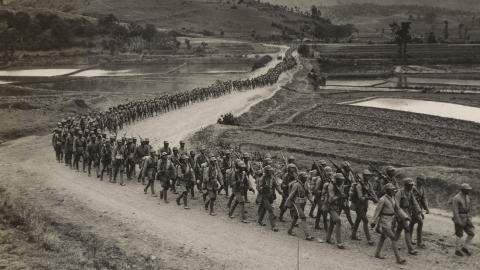Was the destruction of Dresden an Allied war crime?
There’s a story about Arthur ‘Bomber’ Harris, the chief of RAF Bomber Command during the height of World War Two. While he was being driven to London from a military base in High Wycombe, his speeding car was pulled over by an irate police constable. ‘You could have killed someone,’ the constable scolded. ‘Young man,’ Harris replied, ‘I kill thousands of people every night.’
He wasn’t kidding. The war would see Allied bombers bring a kind of biblical wrath to enemy cities, in waves of fiery destruction that have aroused controversy ever since. The most notorious of these operations commenced on 13 February 1945, when Dresden – a city famed for its intellectual culture and architectural beauty – became the target of almost 4,000 tonnes of explosives and incendiary devices. What resulted was a raging firestorm which turned buildings to dust and cremated civilians alive. It’s estimated around 25,000 people died in the inferno of Dresden.
'The people of Dresden believed that as long as the Luftwaffe kept away from Oxford, Dresden would be spared.’
This was by no means an unprecedented act by the Allies. In July 1943, long before Dresden, the Allies unleashed Operation Gomorrah, a protracted assault on Hamburg which literally melted the streets and incinerated people in searing, hurricane-strength winds. More than 20,000 died in just one night of the Hamburg campaign alone, and historians have compared it to the nuclear attacks on Hiroshima and Nagasaki. Then there was the RAF bombing of Pforzheim, a German town, shortly after the Dresden onslaught, which killed almost a third of the population.
Questions have long been raised about the strategic legitimacy of attacks like these, and the later, apocalyptic attack on Tokyo in March 1945, which flattened the city and left around 100,000 dead. It’s Dresden which has attracted most attention by critics, as it was regarded as a capital of culture first and foremost, not a military target. As Victor Gregg, a British POW caught up in the firestorm later said, ‘The people of Dresden believed that as long as the Luftwaffe kept away from Oxford, Dresden would be spared.’
Dr Gregory Stanton, a scholar specialising in genocide, has classified the Dresden bombing as a war crime. Many other experts have agreed, and even suggested that Churchill himself could have been put on trial. German historian Jörg Friedrich, author of a book about the Allied bombings of German cities, went as far as saying ‘Churchill was the greatest child-slaughterer of all time.’
Bomber Harris was explicitly interested in terror as an objective in itself.
Robust justifications have been offered for the Allied area bombings in the latter half of the war. Dresden, for example, was regarded by strategists as far more than some innocent, halo-bathed city of culture, with a United States Air Force report noting the presence of factories playing a part in the Nazi war machine, including some manufacturing poison gas. An American POW being held in Dresden later testified that he ‘saw with my own eyes that Dresden was an armed camp’.
But the potentially damning counterpoint to all of these technical justifications is that Bomber Harris was explicitly interested in terror as an objective in itself. He and other Allied strategists were frustrated by the relative failures of precision bombing raids and advocated massive area bombardments to kill civilians and shatter the enemy’s will. Harris was completely open and unashamed about this, and was actually impatient about other military bigwigs mincing their words about the ferocity of their attacks.
‘The aim of Bomber Command should be unambiguously and publicly stated,’ Harris wrote. ‘That aim is the destruction of German cities, the killing of German workers and the disruption of civilised life throughout Germany.’ As far as Harris was concerned, the Allies had not to just to ‘kill Boche’ but also ‘terrify Boche’.
Such sentiments go a long way to explaining why Harris is still such a controversial and even reviled figure. He would probably defend himself by drawing attention to German raids on the UK – not just the London Blitz, but also the assault on Coventry in November 1940, which was so devastating that Nazi propaganda chief Joseph Goebbels invented a word, ‘coventried’ to describe this kind of catastrophic area bombing.
This is the ‘ends justifying the means’ rationale for Allied area bombing. In a state of total war, with a titanic battle for civilisation against the Nazi menace, with Britain itself coming under severe attack, should not all of Germany be regarded as fair game? By this rationale, the bombings of cities which would have been considered important to Hitler’s regime – including Dresden – could not be seen as war crimes as we know them today.
And yet, all these decades later, the world is still haunted by the epic death tolls and fearful accounts of the wrathful firestorms, and even the queasy words of British politicians of the time, including Lord Salisbury who wrote in a private letter, ‘We do not take the devil as our example.’ This is perhaps the most succinct rebuke to the concept of widescale area or terror bombing: that the ends can never justify the means.
'We do not take the devil as our example.'
The most famous book about Dresden is still Kurt Vonnegut’s novel, Slaughterhouse-Five. Vonnegut, who was a POW in the city during those fateful days and nights, pondered the fact that his account of the attack made him wealthy and famous, saying ‘the Dresden atrocity… was so meaningless, finally, that only one person on the entire planet got any benefit from it. I am that person.’
















